|
stand out against the surrounding
clutter." Likewise, Ada Louise Huxtable of the New York
Times, referred to it as "The finest architectural building
at the Fair." Spain's pavilion, along with those of IBM,
New Jersey and Denmark, was awarded a citation for "Excellence
in Design" by the New York chapter of the American Institute
of Architects.
Although the pavilion included
the usual displays from business and industry, these were not
predominant. Instead, Spain emphasized culture and high art.
Visitors were welcomed to the pavilion by a six-foot statue of
Queen Isabella by contemporary sculptor José Luis Sanchez.
There were frequent flamenco and ballet performances as well
as rotating displays of paintings by renowned Spanish old masters
such as El Greco and Goya as well as avant garde artists, including
Picasso and Miro.
Historical documents, including
those related to Columbus' journey to the New World, were displayed.
Two fine restaurants and an informal cafe featuring international,
Spanish and seafood menus were available to take care of the
body after the soul and mind were sated. Clearly, Spain's pavilion
represented the aspirations of the Fair at its best - to educate
all by presenting the best the country had to offer.
The Journey to Saint
Louis
Alfonso Cervantes, whose
name immediately belies his Spanish ancestry, was the mayor of
Saint Louis at the time of the Fair. He was impressed by Spain's
pavilion and the idea that it would be destroyed and discarded
did not sit well with him.
The early history of Saint
Louis is most closely associated with France. It was founded
in 1763 by Pierre Liguest Laclède and named in honor of
French king "Saint" Louis the 15th. It was ceded to
Spain for a 30-year period in the late 18th Century until being
returned to France at the insistence of Napoleon Bonaparte who
eventually sold it as part of the Louisiana Purchase. Although
it remained French in population and character until its sale
to a nascent United States, Saint Louis may be said to have a
Spanish heritage and it was on this basis that Mayor Cervantes
was able to convince Spain that Saint Louis was the appropriate
place to preserve its pavilion after the Fair.
The pavilion was a gift,
but the gift did not include disassembly, transportation and
reassembly in Saint Louis. This would cost $4 million of which
approximately $1 million was provided by over 10,000 individual
donors. The transportation and reassembly took place as planned
and pavilion was opened to the public in 1967.
Mayor Cervantes' concept
was that the Spanish pavilion would be a downtown convention
and exposition center. It was near several hotels and within
sight of the recently constructed Gateway Arch. It also contained
two of the restaurants which operated at the Fair. Unfortunately,
things did not go well for the pavilion. The convention and exposition
business did not materialize as hoped and after the novelty of
going to fancy Spanish restaurants wore off, there were not enough
return visitors to keep them in business. Within three years
after opening, the pavilion was closed and locked up.
The next and final stage
of the pavilion was as the lobby and meeting center of a downtown
hotel. In a sense this was consistent with the original idea
behind bringing the pavilion to Saint Louis. However, with this
new plan the meeting rooms and restaurant would be integrated
with a hotel rather than separate from it. The hotel tower was
to rise out of the courtyard of the pavilion and construction
on the "Pavilion Hotel" began in 1973. Eventually,
a second tower was built. In 1979 the Marriott company assumed
control of the project and completed the renovation of the pavilion
and hotel.
The Pavilion Today
The hotel where the Spanish
pavilion now resides is located in downtown Saint Louis between
Busch Stadium and Kiener Plaza. It is across the street from
the historic Saint Louis Courthouse and within walking distance
of the Gateway Arch. The hotel was known as the "Marriott
Pavilion Saint Louis" until at least 2002. Sometime between
2002 and 2005 the reference to the pavilion was dropped and the
name changed to the "Saint Louis Marriott Downtown."
However, even today [2005] the web address for the hotel contains
the letters "STLPV" at the end which suggest "Saint
Louis Pavilion" and the hotel restaurant is named the "Pavilion."
In addition, there is a plaque at the entrance to the hotel that
explains its history.
As you approach the hotel's
main entrance on Broadway and Market and compare the view to
the various pictures of the pavilion on the nywf64.com website
you can see that the configuration of the exterior of the pavilion
remains intact. Even the two flag poles appear to be close to
their original locations.
The small white outcropping
at the right of the pavilion [The Madrid Tavern during
the Fair] is now "Pitcher's Sports Bar and Grille."
It has two windows and a door but otherwise looks pretty much
the same as it did in 1964-65. Just west of the main entrance
and behind the Bar an addition has been attached to the pavilion.
This encloses an escalator and small second floor lobby area.
The wall of the east side
of the building has stained glass embedded in it. Presumably
at one time light was allowed to shine through the glass but
this is no longer the case. The interior wall behind the stained
glass is now solid.
-
This
wall was an exterior wall of the Museum in the Spanish Pavilion
at the World's Fair, specifically, the room in which were displayed
Romanesque paintings and medieval sculpture. The window was made
specially for the Pavilion by artist Manuel Molezun and was intended
to enhance the atmosphere of the room. The image on the right
is taken from the Guide to the Pavilion of Spain and shows how
the Stained Glass looked in the Pavilion at the Fair.
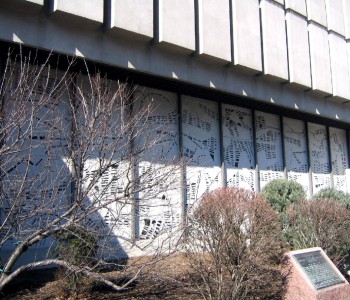 |
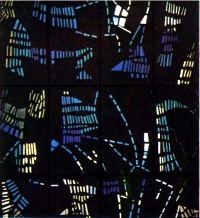 |
The main portion of
the pavilion is composed of two floors and a lower level. The
first floor includes the hotel lobby, a Kinko's and a Starbuck's
Coffee shop in addition to several meeting rooms. The Pavilion
restaurant is in the lower level west of the lobby. The second
floor contains additional meeting rooms and the interior has
little to suggest the structure's unique history. Accordingly,
my pictures of the interior are all from the first floor. I do
not recall the interior from the Fair well enough to know how
much is original. Certainly, pictures of the original courtyard
indicate that major changes have been made in that area. A roof
now covers the courtyard and a tower rises out of the center!
However, much of the interior of the first floor is at least
in character with the original.
The first of the following
pictures is a view facing Broadway and shows the main lobby and
front desk. The edge of the Starbucks sign is just visible on
the left.
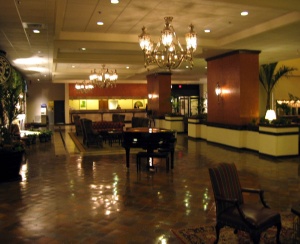
Another view of the lobby
looks toward the north side of the hotel just east of the Starbucks.
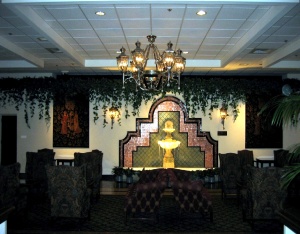
A final view of the lobby
is from a different angle than the first two.
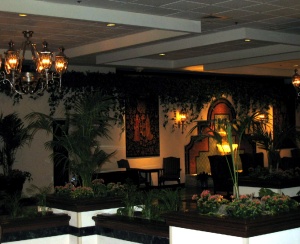
This picture shows the
fountain in more detail. It certainly looks like it is an original
fixture from the pavilion but I do not know for sure.
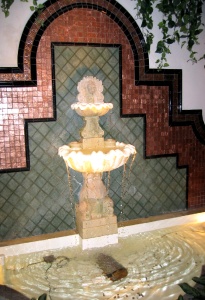
There is a corner of the
lobby on the south side next to the elevators that has two interesting
artifacts that appear to be original. The first is a seat and
the second is a statue of Queen Isabella. Although this appears
to be the Isabella statue that stood outside the Pavilion at
the Fair, I understand that more than one copy of the Sanchez
statue was cast so I cannot be sure.
Here's the seat, which
has a good deal of ornate carving and currently has some cleaning
supplies unceremoniously stored under and next to it .
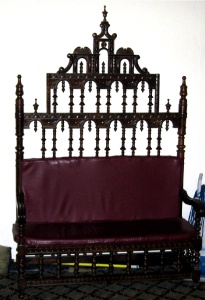
Next we have Queen Isabella
offering her jewelry to finance Columbus' trip to the New World.
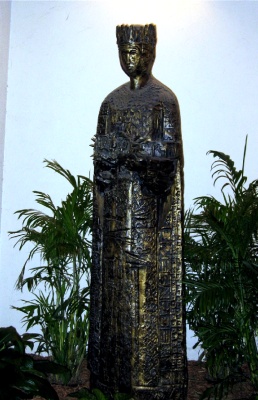
Not far away from the main
lobby on the first floor is a series of meeting rooms, including
one with an ornately carved wood door that must certainly been
from the original pavilion.

The final picture in this
series is of the entrance to the Pavilion restaurant. Unfortunately,
Randy and I arrived after their closing time (9:00 PM) so we
were unable to dine there as planned. However we did find a pleasant
Italian restaurant across Kiener Plaza and were able to pass
some time over pasta and beer discussing matters of importance
and insignificance related to the Spanish pavilion and the Fair.
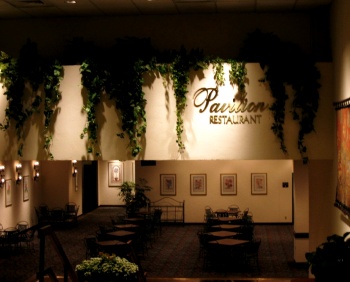
Closing Thoughts
While all Fair enthusiasts
would prefer to see the pavilions preserved as they were in 1964-65
we know this is impossible. Even the pavilions that remained
in Flushing Meadows-Corona Park have undergone significant changes,
some for the better and others not for the better. All things
considered, I think that the Marriott Corporation is to be commended
for keeping the Spanish Pavilion basically intact and in good
condition. Adapting it for use as a hotel lobby, restaurant and
meeting area was a clever idea and ensured that the pavilion
was preserved in some form.
Marriott is fairly low
key about the hotel's history. The only external clues are the
plaque near the main entrance and the name of the restaurant.
However, I think that World's Fair enthusiasts will be pleased
at what they see if they visit. If you find yourself in Saint
Louis, definitely go over and take a look.
|